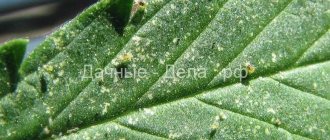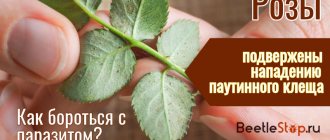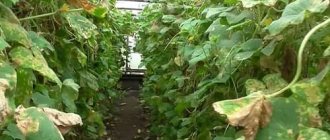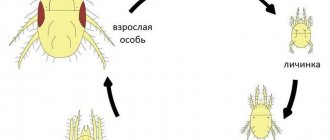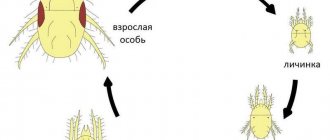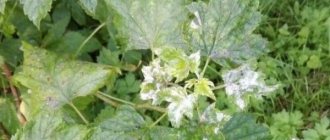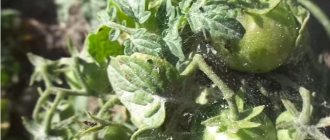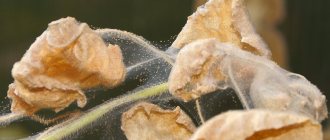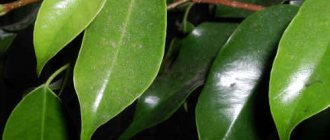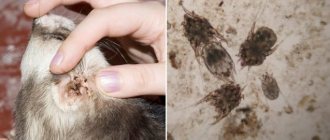| Place | Name | Characteristics in the rating |
| The best acaricides for spider mites |
| 1 | Neoron | Best for controlling ticks at all stages of their development |
| 2 | Apollo | Lowest toxicity. Long validity period up to 60 days |
| 3 | Omite | Prolonged effect for 3 weeks |
| The best insectoacaricides for spider mites |
| 1 | Aktellik | The most versatile remedy |
| 2 | Fufanon | Analogue of Karbofos |
| 3 | Talstar | Safe for bees |
| The best biological products for spider mites |
| 1 | Fitoverm | The best enteric contact bio-insectoacaricide |
| 2 | Kleschevit | The most popular |
| 3 | Bitoxibacillin | Best in terms of security |
| 4 | Metarizin | Acts slowly and prolonged |
Almost everyone has to fight spider mites, which attack vegetable crops in open ground and greenhouses, and also often appear on indoor plants, from time to time. The pest is tiny in size, but can adapt to different living conditions. The only solution is to regularly treat the plants using special means to combat the parasite.
Effective drugs against spider mites will help save flowers in the apartment, protect cucumbers and other vegetable crops in the garden. There are many means available for these purposes. They differ in price, composition and principle of action. We have compiled a rating of the best drugs against spider mites, based on reviews from gardeners.
Instructions for the use of acaricides
Acaricidal preparations against ticks are used for spraying the above-ground parts of plants. To do this, prepare a solution in specially designated plastic, glass or enamel containers. The skin of the hands is protected with rubber gloves, the respiratory organs and eyes are protected with respirators and glass goggles.
The preparation method for most acaricidal preparations is the same:
- First, take half of the total volume of water, dilute the required amount of the drug until a homogeneous liquid is obtained.
- Then the rest of the water is added to the container and the resulting liquid is intensively mixed.
- The composition is poured into the spray tank.
The solution is used immediately in full. It cannot be stored for more than one day.
Top Chemicals for 2022
When using drugs from this group, it is important to strictly follow the dosage and number of treatments in accordance with the attached instructions. Chemical agents that destroy ticks are divided into two groups:
- insectoacaricides;
- acaricides.
To effectively get rid of the pest, you should alternate products with different components in the composition. Many products cease to perform their function after repeated treatment.
If you need to use chemicals, you must follow a number of simple but important rules:
- During use, wear long sleeves, gloves and a hat to protect skin, mucous membranes and hair. The best place for spraying chemicals is a balcony, loggia.
- For indoor flowers, choose products with toxicity class 3-4. Highly toxic substances are only suitable for outdoor plants.
- In case of serious infection, it is necessary to carry out not one, but 4 treatments with an interval of 5-7 days.
Examples of chemicals and their use are presented in the table:
| Name | Protection time (days) | Peculiarities |
| Akarin | 8-15 | Provides assistance within 48 hours. Suitable for roses, violets and orchids. |
| Aktara | 14 | It does not have an unpleasant odor, but is considered ineffective against ticks. |
| Aktellik | Toxic, it is better to spray outside. Do not allow it to get into the ground. | |
| Anti-mite | 7-9 | Defeats different types of pests. |
| Apollo | 60-90 | Sterilizes adults. |
| Bi-58 | 21 | Prevents the emergence of new colonies of parasites. |
| Nissan | 50 | The effect is visible after 11 days. |
| Neoron | 10-40 | Can be used at any humidity and air temperature. |
| Omite 30 and 57 | 14 | Available in different dosages. |
| Oberon | 20-25 | Destroys all stages of insects: eggs, larvae, adult females, except males. |
| Sunmite | 30-35 | The impact on masonry is minimal. |
| Skelta | 80-85 | The death of the pests occurs within a week. Requires re-spraying after 8 days. |
| Fitoverm | 20 | Low toxicity, but re-treatment is required. |
Due to the fact that all mites are similar in structure, flower growers use drugs used in veterinary medicine to treat animals, for example, Neostomozan.
For treatment to be effective, it is better to alternate the use of acaricides and water procedures. Plants in large tubs, as well as specimens with curled leaves or curly dense crowns, for example, ficus, are best dipped into a bucket with diluted products, greens side down, for 1-2 minutes.
MOST READ FROM PARTNERS
Sometimes on forums they suggest using Dichlorvos. This should not be done, the product does not help against ticks, but when sprayed in an apartment it is harmful to human health.
Almost everyone has to fight spider mites, which attack vegetable crops in open ground and greenhouses, and also often appear on indoor plants, from time to time. The pest is tiny in size, but can adapt to different living conditions. The only solution is to regularly treat the plants using special means to combat the parasite.
Effective drugs against spider mites will help save flowers in the apartment, protect cucumbers and other vegetable crops in the garden. There are many means available for these purposes. They differ in price, composition and principle of action.
Frequency of application
How often to use the acaricidal drug depends on the technical characteristics. Some systemic substances are actively absorbed by plant parts, so their use before harvesting fruits is strictly prohibited.
Acaricidal preparations against ticks are used not only to eliminate ticks, but also to repel other insects. Acaricides can be used as preventive drugs, as well as as a comprehensive measure to eliminate an existing problem.
Where do spider mites come from on houseplants?
There are a great many sources of spider mites appearing on house plants . We list both the most basic and the most unexpected, at first glance, routes of infection:
Most often, the tick “arrives” in the house on the leaves of purchased indoor plants . All flower growers unanimously repeat: if you bought a new flower in a store or from hand, do not immediately place it on your plants. Place the newcomer in quarantine on a separate windowsill, or better yet, immediately wash the crown of the plant with laundry soap and carry out preventive spraying with any pest control agent.
The second most “popular” route of infection is flower bouquets . If you brought a bouquet of your garden flowers or were given one for a holiday, try to place the vase with flowers away from indoor plants.
In third place, spider mite infection through the ground . Experienced gardeners never prepare planting mixtures in the same room where the plants are located. Spider mite eggs can sleep peacefully in the ground for up to 5 years, waiting for favorable conditions. Any soil, forest garden soil or store-bought soil, must be calcined in the oven, because it may contain many dangerous bacteria, fungal spores and pest eggs.
The fourth way to become infected with mites perfectly explains how they “out of the blue” appear on plants. Attention! Spider mites can fly! Of course, they do not have wings, but the thin webs produced by the glands of the tick can serve as an excellent parachute, allowing them to soar with the wind over vast distances.
Ticks can also be brought on clothing , shoes, an umbrella, or even on a Christmas tree.
The crown of the plant, entangled in cobwebs from spider mites
There are a great many ways for spider mites to enter your home, and even if this attack has passed for now, you should be prepared for the possible appearance of these uninvited guests.
How not to deal with spider mites
- When purchasing a new plant, isolate it from your flowers;
- Maintain room humidity; mites love dry air;
- Rinse the leaves of plants regularly, preferably with the addition of laundry soap;
- Inspect houseplants daily for signs of infestation;
- Follow agricultural practices, because healthy and strong plants are very unattractive to the pest.
Attention to plants returns in the form of their beauty and health
When diluting a solution to combat spider mites on indoor plants, be sure to follow the instructions for use on the package. The recommendations posted here are based on currently available products, but the manufacturer may vary the concentration of the active ingredient from batch to batch.
And here you can learn even more about methods of combating spider mites on homemade lemons.
Arsenal of chemicals for pest control
There is a wide range of drugs available to control pests on houseplants. These are insecticides, acaricides, and insectoacaricides . Buyers coming to a country store are sometimes simply not able to independently navigate the variety of multi-colored bottles, ampoules, tubes, powders and sprays on offer. instructions for use flash one after another , you can go crazy. Therefore, we will try to understand this variety of drugs and find effective chemicals for spider mites .
Holes on a leaf that an insect leaves when feeding on its juice
Insecticides
This term refers to a wide range of drugs of natural or chemical origin intended to destroy various types of pests.
All drugs in this group can be divided into several criteria:
According to the method of destroying pests, the following drugs are distinguished:
- Intestinal - penetrate the body of pests along with food, are especially effective for destroying various leaf-eating insects and moths.
- Contact - kill pests as a result of contact with their body. It is this group of drugs that is used in industrial agriculture for spraying onto fields from aircraft.
- Systemic - a group of drugs that are absorbed by plants, making their juice poisonous to pests. Unlike intestinal preparations, which remain as a film on the surface of the leaf, systemic preparations will not be washed away by rain or watering.
- Respiratory - a group of sprays familiar to everyone that kill pests through the respiratory system.
- Translaminar - a group of drugs that can spread from the point where drops of the drug hit the entire untreated surface of the plant.
According to the spectrum of impact on pests of one or another group, the following are distinguished:
- Antihelminetics are drugs used mainly in veterinary medicine, livestock and poultry farming to combat worms, roundworms, pinworms and other exoparasites of animals and poultry.
- Nematicides are used to destroy nematodes, in particular those types of roundworms whose presence is undesirable, in other words, pests.
- Acaricides are a specialized group of drugs to combat ticks. These are the drugs that will help gardeners effectively combat spider mites on plants . Let's talk about them in more detail.
Insecticidal preparations are available for retail sale in the following forms:
- In the form of a concentrated suspension, abbreviated as CS . It is a liquid solution containing tiny, solid particles. If you leave the suspension on a shelf for a long time, you may notice the release of sediment. It is on drugs of this class that it is written “Shake before use/use.”
- In the form of a concentrated emulsion, abbreviated as CE . It is a mixture of two types of liquids. An example of an emulsion would be a mixture of oil and water. Emulsions, like suspensions, are prone to separation, so they should also be shaken thoroughly before use.
- In the form of sticks containing the drug, abbreviated as P. The most convenient form of release for flower growers, which allows you to avoid various spraying and dusting. It is enough to simply place the stick in a pot with an infected plant and wait for the inevitable death of the pests.
- In the form of a wettable powder, abbreviated as SP . This form of release is a tiny powder with which surfaces are dusted. A classic example, banned in our time, but familiar from childhood, is DDT, or dust.
Why is it dangerous?
Spider mites are herbivorous arachnids.
Their main food is cell sap, which they suck out through numerous punctures on the leaves. The affected leaves dry out and fall off, the plant cannot develop normally, form buds and fruit ovaries.
Moving from one plant to another, mites carry dangerous viruses, fungi, and bacteria. Arachnids are not capable of flying, but are easily transported by the wind along with cobwebs. After overwintering, the pests quickly restore the population and can completely destroy the crop.
Results of a review of anti-spider mite remedies
Summing up our review, it should be noted that any pesticides have their drawbacks, a strong odor, allergies, and the need for ventilation after treatment. Experienced flower growers know that chemistry, as a remedy for spider mites , is the most extreme measure. Preventing the appearance of ticks and creating barriers to their appearance in the apartment is the best way to avoid misfortune.
Beautiful and healthy plants for you
Acacricides and insectoacaricides in the florist's arsenal.
The group of acaricidal drugs includes both specific agents aimed at destroying a specific type of mite , and agents with a broad spectrum of action on the pest, the so-called insectoacaricides.
Let's look at the anti-spider mite chemicals available today for gardeners , and also give general recommendations for use . But we remember that before opening any drug, you must first read the instructions for use .
Specific acaricides, selective agents against spider mites.
1. Apollo, KS
Apollo, KS , a drug based on a solution of clofentesine . The concentration of the active substance is 500 grams per liter of suspension. Available in the form of ampoules of 2 milliliters, half-liter bottles and canisters of 1 liter or more. Country of origin: Israel.
Mechanism of action: contact acaricide designed to sterilize adults and destroy egg clutches and young larvae of spider mites and red mites . Period of protective action: approximately 30-40 days, depending on the type of plant. Chemical class: hormonal-type drugs.
Hazard class: 4 (substances of low toxicity).
Resistance : by preventing the emergence of new generations of pests, the drug does not allow the development of resistance.
Method of application: it is recommended to dilute the suspension first in a small amount of water, then bring the solution to a working concentration. The resulting Apollo solution is poured into a spray bottle, and with its help the entire plant is generously sprayed. After the initial spray has dried, repeat the procedure. The drug is safe for animals, humans and beneficial insects.
2. Flumite, KS
Flumite, KS , a drug based on flufenzine . The concentration of the active substance is 200 grams per liter of suspension. Available in 1 liter bottles and 3 liter canisters. Manufacturer: Hungary.
Its mechanism of action: Contact-transmylar chemically active drug that sterilizes female mites , destroying oviposition and larvae of all stages.
Period of protective action of Flumite : 1-1.5 months.
Chemical class : Pesticide of the tetrazine class of drugs.
Hazard Class: 3- 4
Resistance of the product : by preventing the emergence of new generations of pests, the drug does not allow the development of resistance.
Method of using Flumite: Dissolve this drug in a small amount of liquid, then increase the concentration of the suspension to 1 milliliter per 2.5 liters of water. Spray the leaves of indoor flowers generously once with the working solution. The drug selectively acts only on ticks and is safe for animals and other types of insects.
3. Neoron, KE
Neoron, CE , the drug is based on broirolylate . The concentration of the active substance is 500 grams per liter of emulsion. Available in sealed ampoules of 5 and 2 milliliters. Country of origin: Hungary.
Mechanism of action : Contact acaricidal drug with selective action, destroying larvae and adults. Has a weak effect on tick oviposition.
Period of protective action : from 10 days to a month, depending on how severely the plants are affected and the type of plants themselves.
Chemical class : the drug belongs to the group of benzylates.
Hazard Class: 4
Resistance : If the manufacturer's recommendations are strictly followed, resistance is excluded.
Directions for use : Apply a suspension solution with a concentration of 10 to 20 milliliters per 7 liter bucket of water. The concentration of Neoron depends on the degree of plant damage. A bucket of ready-made working solution will be enough to process 10-15 flowers. It is important to carefully apply the preparation to both sides of the plant's leaves, because it is on the back of the leaf that the females lay their eggs. You should avoid getting the drug into the soil; you can even put a plastic bag on the pot with the plant.
4. Nissan, JV
Nissoran, SP , is an enteric acaricide that also exhibits slight transmylar properties. The active ingredient in this drug is hexythiazox , which is a hormonal chemical. The concentration of the active substance is 10 grams per 100 grams of powder. Available in the form of powder packets. Manufacturer: Japan.
Mechanism of action: In terms of its action, Nissoran is a contact drug. The complex hormonal effect of the drug effectively stops the growth and development of clutches and larvae and makes adults sterile.
The period of its protective action: from one to one and a half months, which is quite long.
Chemical class: Belongs to the so-called class of biological pesticides.
Hazard Class: 4
Resistance : To prevent the occurrence of resistance, plants should be treated with Nissoran no more than once a year.
Directions for use : To prepare the solution, dissolve the powder of the drug in a concentration of 1 gram per 1 liter of water. Thoroughly moisten all surfaces of the indoor plant with the working solution from a spray bottle. Do not use old solution, only fresh one.
Omite, SP and CE
Omite, SP and CE , contact acaricide. The active ingredient of the drug is propargite . The concentration of the active substance is 300 grams per kilogram of powder or 570 grams per liter of emulsion. Available in the form of powder packets or emulsion bottles.
Mechanism of action : Nissoran is a contact acaricide. , which destroys the larvae of this pest and mature mites , has a minimal effect on clutches; almost all eggs remain capable of hatching and producing offspring. A series of treatments is required.
Protective period : 21 days.
Chemical class : chemical pesticide made from ether sulfites
Hazard class : 2nd for warm-blooded insects, 3rd for beneficial insects.
Resistance : no cases of resistance have been recorded.
Directions for use : Dissolve the powder or emulsion of the drug in water. Thoroughly moisten all surfaces of the indoor plant. During operation, the insecticidal solution must be constantly stirred.
Ortus, SK
Ortus, SC , a contact acaricide based on phenpyroximate . The concentration of the active substance is 50 grams per liter of suspension. Available in both bottles and canisters of 5 liters.
Mechanism of action: A drug with a contact mechanism of action that disrupts the vital activity of ticks at the level of ion metabolism. Destroys larvae and adult ticks, sterilizes eggs of the pest.
Period of protective action of the drug Ortus : 1 month.
Chemical Class: Juvenoid Chemical Pesticide .
Hazard Class: 3
Resistance : The tendency to develop stable resistance is low; repeated treatment with Ortus is allowed, if necessary, multiple times.
Method of using Ortus : Dissolve the drug in water at the rate of 5-10 milliliters per bucket. All surfaces of the plant are thoroughly moistened with the working solution, especially the underside of the leaves.
7. Sunmite, JV
Sunmite, SP , is a contact acaricide based on pyridabene . The concentration of the active substance is 200 grams per kilogram of the drug. Available in powder form, half a kilo sachets. Manufacturer: Japan.
Its mechanism of action : this chemical drug Sunmite acts on ticks contactally , at the level of ion exchange. It disrupts the functioning of the pest body, with a particularly detrimental effect on adults and larvae . The impact on masonry is minimal.
Period of guaranteed protective action : from 1 month to 40 days.
Chemical class : the drug belongs to the pyridazinones .
Hazard class : 3 (moderately dangerous).
Resistance : To exclude the possible emergence of resistance, it is not recommended to use the drug more than once a year.
Directions for use : To destroy spider mites, mix the drug at the rate of 1 gram per 1 liter of liquid. Thoroughly treat the plant leaves with the working solution until they are completely moistened. The pest stops feeding within a couple of hours and dies a few days later.
Avermectins
1. Fitoverm, CE
Fitoverm, EC , Contact-intestinal type of acaricide, created on the basis of aversectin . The concentration of the active substance is 2 grams per liter of emulsion. It goes on sale both in the form of ampoules of 2 milliliters and in the form of bottles of 10-500 milliliters. Manufacturer: Russia.
Mechanism of action: The drug destroys ticks through direct exposure, as well as by entering the intestines. Under the influence of Fitoverm, a malfunction occurs in the tick's body and its subsequent death . Destroys many types of harmful insects, not just ticks.
Period of protective action : 7-20 days
Chemical class : biological insecticide.
Hazard Class: 2-3
Resistance : The number of occurrences is minimal, repeated use is allowed.
Directions for use : The acaricide is diluted in clean water at the rate of 2-5 milliliters per liter of liquid and applied generously to all surfaces of the plant. .
2. Vertimek
Vertimek, EC , Enteric-contact type insectoacaricide, based on the biological substance - abamectin. KDV - 18 grams per 1 liter of emulsion. It goes on sale both in 250 milliliter bottles and in canisters up to 5 liters. Production - Switzerland.
Mechanism of action : The drug destroys ticks by contact , as well as by getting into the intestines. Under the influence of Vertimek, all functions of the tick's body fail and, as a result, it dies. Destroys not only ticks.
Period of protective action : 1-2 weeks.
Chemical class : biological insecticide.
Hazard Class: 2
Resistance : The risk of addiction is minimal, repeated use is allowed.
Directions for use : Diluted in clean water, 2-3 milliliters per bucket of water is enough and apply generously to the plant. Vertimex cannot be mixed with other types of pesticides in the same working solution, but a mixture with growth stimulants is acceptable.
Spark bio, CE
Iskra bio, EC , contact-intestinal type of insectoacaricide, based on the biological substance - abamectin N.
Concentration of active substance : 2 grams per liter of emulsion. It goes on sale both in 10 milliliter bottles and in ampoules of 2 milliliters. Production - Switzerland.
Mechanism of action: The drug destroys ticks by contact, as well as with plant juices. Under its influence, the tick stops feeding and growing and, as a result, its death. Destroys a variety of types of harmful insects. Iskra double effect is also produced, with a mixture of cypermethrin and permethrin.
Period of protective action : 1-2 weeks.
Chemical class : biological insecticide.
Hazard Class: 2
Resistance : The risk of occurrence is minimal, repeated treatment is allowed, re-treatment is allowed after a week.
Method of use : As a remedy for spider mites, it is necessary to dilute Spark in clean water, adding 2-3 milliliters per liter of water and apply generously to the leaves and shoots of flowers. Iskra Bio should not be mixed with other pesticides of chemical origin in the same solution.
4. Kleschevit, KE
Kleschevit, EC , contact-intestinal type of insectoacaricide, based on the biological substance - abamectin N, concentration 2 grams per liter of emulsion. It goes on sale both in 10-milliliter bottles and 4-milliliter ampoules. Production - Russia.
Mechanism of action : The drug destroys ticks by contact, as well as by penetrating the intestines. Under the influence of Kleschevit, the pest's respiratory system is paralyzed and its death occurs in just 6-8 hours. Destroys aphids, thrips, whiteflies, and not just mites.
Period of protective action : 1-2 weeks.
Chemical class : biological insecticide.
Hazard Class: 2
Resistance : No cases of occurrence have been recorded.
Method of use : As a means of combating ticks, Kleschevit is dissolved in water at the rate of 2 milliliters per liter of water and abundantly moisturize all plant surfaces. The insectoacaricide is minimally toxic to warm-blooded animals and people, but dangerous to pollinating insects.
Agravertin, CE
Agravertin, EC , a contact-intestinal type of insectoacaricide, based on the biological substance abamectin N. The concentration of the active substance is 2 grams per liter of emulsion. It goes on sale both in the form of bottles of 10 milliliters and ampoules of 2 milliliters. Production - Switzerland.
Mechanism of action : The drug destroys ticks by contact, as well as by getting into the intestines. Under the influence of Agravertine, paralysis of the pest’s nervous system occurs and its death. Destroys a wide range of pests (aphids, thrips, etc.), not just mites. Period of protective action: 1-2 weeks.
Chemical class : biological insecticide.
Hazard Class: 2
Resistance : The occurrence of resistance is minimal, repeated treatment is allowed, repeated treatment is allowed after a week.
Method of use : As a remedy for spider mites, the drug is dissolved in water at the rate of 2-3 milliliters of the drug per liter of water and applied generously to the plant. Agravertine should not be mixed with other pesticides of chemical origin in the same working solution. The drug is not toxic to pollinating insects and can be used during flowering.
Pirimiphosmethylins
Aktellik, CE
Actellik, EC , a drug based on pirimiphos-methyl. The concentration of the active substance is 500 grams per liter of emulsion. Available in 5 liter bottles and 2 ml ampoules. Manufacturer: Switzerland.
Mechanism of action : a drug of intestinal and contact action, disrupting the synthesis of enzymes in female mites, destroying oviposition and larvae of the pest.
Period of protective action : 20-30 days
Chemical class : The pesticide belongs to the organophosphate class.
Hazard Class: 3
Resistance : by preventing the emergence of new ticks, it does not allow the development of resistance.
Directions for use : First, dilute the drug in a small amount of water, then you need to bring the concentration of the emulsion to 1 milliliter per liter of working solution. Apply the prepared solution generously to the leaves of indoor flowers once. Actellik affects not only ticks, it also affects other pests, and is safe for people and beneficial insect species.
Dimethoate-containing
Etisso Blattlaus-Sticks (Etisso)
Etisso Blattlaus-Sticks (Etisso), P, the sticks of which are made on the basis of a mixture of potassium-phosphorus fertilizer and dimethoate . Designed to simultaneously nourish and protect indoor plants. Manufacturer: Germany.
Mechanism of action : The drug simultaneously nourishes and protects plants.
Period of protective action : 20-30 days
Chemical class : Dimethoate-containing type pesticide.
Hazard Class: 4
Resistance : none.
Method of use : Sticks are placed in the ground around the indoor flower. The number of sticks can vary from one to 10, depending on the size of the plant.
BI58 New, CE
BI58 New, CE , drug based on diomethate . The concentration of the active substance is 400 grams per liter of emulsion. Canisters from 1 to 10 liters and 5 milliliter ampoules are available. Manufacturer: Germany.
Mechanism of action : the drug is a systemic, contact method of action that disrupts the synthesis of enzymes in female mites, destroying oviposition and larvae of all ages.
Period of protective action : 21 days.
Chemical class : Organophosphorus type pesticide.
Hazard Class: 3
Resistance : By preventing the emergence of the next generation, it does not allow the development of resistance.
Directions for use : First dilute the product in a small amount of water, then adjust the concentration of the emulsion to 1 milliliter per 1 liter of water. Only soft, clean water should be used. Spray the leaves of indoor flowers generously once with the working solution. The drug acts not only on ticks, it also affects other types of pests , and is safe for animals and beneficial insect species.
Buprofezin-containing
Applaud
Applaud (Applaud), SP, contact-intestinal type of insectoacaricide, based on buprofezin . The concentration of the active substance is 250 grams per kilogram. It goes on sale in the form of 500 gram bags. Production - Japan.
Mechanism of action : The drug destroys ticks by contact, as well as by getting into the intestines. Under the influence of the drug, the production of chitin in the pest’s body is disrupted and its death. Kills a wide range of pests, not just mites.
Period of protective action : 20-40 days.
Chemical class : Chitin synthesis inhibitor.
Hazard Class: 3
Resistance : The occurrence of addiction is minimal, repeated treatment is allowed, repeated treatment is allowed after 20 days.
Method of use : As a remedy for spider mites, the drug is dissolved in water at the rate of 1 gram of the drug per liter of water and applied generously to the plant. The death of spider mites does not occur immediately, but within a week, but the effect is long-lasting.
Malathion-containing
Karbofos, JV
Karbofos, SP contact type of insectoacaricide, based on melathion . The concentration of the active substance is 570 grams per kilogram of powder. It goes on sale in the form of plastic bags of 500 grams. Production - Denmark.
Mechanism of action : The drug destroys ticks when they come into contact with the body, as well as when they enter the intestines. Under it, the pest’s nervous system is paralyzed and its death occurs. Destroys many types of pests, not just mites.
Period of protective action : 5-10 days.
Chemical class : organophosphate class of insectoacaricides.
Hazard Class: 3
Resistance : The occurrence of resistance is minimal, repeated treatment is allowed, repeated treatment is allowed after a week.
Method of use : As a remedy for spider mites, the drug is dissolved in water at the rate of 50 grams of the drug per 5 liters of water and applied generously to the plant. Spraying should be done using a spray bottle so that the droplets are extremely small and the product does not get into the ground. Mix the drug thoroughly during processing.
Fufanon, KE
Fufanon, EC , a contact type of insectoacaricide, based on melathion . The concentration of the active substance is 570 grams per kilogram of emulsion. It goes on sale in the form of plastic ampoules from 2 to 10 milliliters. Manufactured in Denmark. An analogue of the well-known Karbofos .
Mechanism of action : The drug destroys spider mites upon contact, as well as entering the intestines. Under the influence of Fufanon, the pest’s nervous system is paralyzed and its death occurs. Kills a fairly wide range of pests (aphids, thrips, etc.), and not just mites.
Period of protective action : 5-10 days.
Chemical class : organophosphate type insectoacaricides.
Hazard Class: 3
Resistance : No occurrence was observed, repeated use is allowed, re-treatment is allowed after a week.
Method of use : As a remedy for spider mites , the drug is dissolved in water at the rate of 5 milliliters of the drug per 5 liters of water and applied generously to the plant. Spraying should be done using a spray bottle so that the droplets are extremely small and the product does not get into the ground.
Kemifos, KE
Kemifos, EC contact intestinal type of insectoacaricide, with a fumigation effect, based on melathion. The concentration of the active substance is 570 grams per liter of emulsion. It goes on sale in the form of plastic ampoules from 2 to 10 milliliters. Production - Denmark. Also an analogue of the well-known Karbofos.
Mechanism of action : The drug destroys ticks by contact, as well as by getting into the intestines. Under the influence of Kemifos, paralysis of the pest’s nervous system occurs and its death. Under the influence of the vapors of the drug, egg layings also die. Destroys a wide range of pests (moths, bedbugs, whiteflies, etc.).
Period of protective action : 5-10 days.
Chemical class : organophosphate class of insectoacaricides.
Hazard Class: 3
Resistance : The occurrence of resistance is minimal, repeated treatment is allowed, repeated treatment is allowed after a week.
Method of use : As a remedy for spider mites, the drug is dissolved in water at the rate of 5 milliliters of the drug per 5 liters of water and applied generously to the plant. Spraying should be done using a spray bottle so that the droplets are extremely small and the product does not get into the ground.
Cypermethrin-containing
Inta-vir, VRP, TAB
Inta-vir, VRP, TAB , contact-intestinal type of insectoacaricide, based on pyrethroids. The concentration of the active substance is 37.5 grams per kilogram. It goes on sale in the form of tablets weighing 8 grams. Production - Russia.
Mechanism of action : The drug destroys ticks by contact, as well as by getting into the intestines. Under the influence of Inta-vir, paralysis of the pest’s nervous system occurs and its death within 2-3 days. Destroys a wide range of pests (aphids, thrips, etc.), not just mites.
Period of protective action : 1-2 weeks.
Chemical class : peritroid class.
Hazard Class: 3
Resistance : The occurrence of resistance is minimal; the drug can be used up to three times a year.
Directions for use : The drug is dissolved in water at the rate of one tablet per 10 liters of water and applied generously to the plant. Do not mix in the same working solution with other pesticides that have an alkaline reaction.
Iskra, SP, TAB
Iskra, SP, TAB , contact-intestinal type of insectoacaricide, based on pyrethroids. The concentration of the active substance is 37.5 grams per kilogram. It goes on sale in the form of tablets weighing 10 grams. Production - Russia.
Mechanism of action : The drug destroys ticks by contact, as well as by getting into the intestines. Under the influence of the Spark, paralysis of the pest’s nervous system occurs and its death within 2-3 days. Destroys a wide range of pests.
Period of protective action : 1-2 weeks.
Chemical class : peritroid class.
Hazard Class: 3
Resistance : The occurrence of resistance is minimal; the drug can be used up to three times a year.
Directions for use : The drug is dissolved in water at the rate of one tablet per 10 liters of water and applied generously to the plant. Use a spray bottle to obtain the minimum droplet size of the drug. This will significantly improve processing efficiency.
Characteristic symptoms of infection
Spider mites are very small insects, so no visible symptoms appear immediately after a plant is infected. But as the pest population increases, clear signs of infection appear:
A silvery web is visualized. When heavily infested, it envelops all plants. While the tick colony has not yet increased, the cobweb is hardly noticeable. Because of this, novice flower growers and gardeners may miss the initial stage of infection.
The pest pierces the surface of the leaf blades with a sharp proboscis in order to suck out nutrients. The tissues adjacent to the punctures die. Visually this is manifested by the appearance of very small dots. They may have a greenish or light yellow color. After some time, they merge into more noticeable spots.
The parasite leaves its waste products, dynamically changing its location on the plant or moving to a neighboring one. They resemble small black grains that are easy to separate from the surface of the leaves.
If the affected plant is not taken care of, it will quickly die. Microscopic wounds left by spider mites cause yellowing and wilting of leaves and young shoots. The condition is aggravated if mycosis also develops. The plant will most likely die, but first the damaged parts will fall off.
